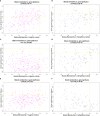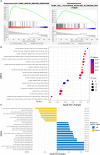Integrated Analysis of Gene Co-Expression Network and Prediction Model Indicates Immune-Related Roles of the Identified Biomarkers in Sepsis and Sepsis-Induced Acute Respiratory Distress Syndrome
- PMID: 35844622
- PMCID: PMC9281548
- DOI: 10.3389/fimmu.2022.897390
Integrated Analysis of Gene Co-Expression Network and Prediction Model Indicates Immune-Related Roles of the Identified Biomarkers in Sepsis and Sepsis-Induced Acute Respiratory Distress Syndrome
Abstract
Sepsis is a series of clinical syndromes caused by immunological response to severe infection. As the most important and common complication of sepsis, acute respiratory distress syndrome (ARDS) is associated with poor outcomes and high medical expenses. However, well-described studies of analysis-based researches, especially related bioinformatics analysis on revealing specific targets and underlying molecular mechanisms of sepsis and sepsis-induced ARDS (sepsis/se-ARDS), still remain limited and delayed despite the era of data-driven medicine. In this report, weight gene co-expression network based on data from a public database was constructed to identify the key modules and screen the hub genes. Functional annotation by enrichment analysis of the modular genes also demonstrated the key biological processes and signaling pathway; among which, extensive immune-involved enrichment was remarkably associated with sepsis/se-ARDS. Based on the differential expression analysis, least absolute shrink and selection operator, and multivariable logistic regression analysis of the screened hub genes, SIGLEC9, TSPO, CKS1B and PTTG3P were identified as the candidate biomarkers for the further analysis. Accordingly, a four-gene-based model for diagnostic prediction assessment was established and then developed by sepsis/se-ARDS risk nomogram, whose efficiency was verified by calibration curves and decision curve analyses. In addition, various machine learning algorithms were also applied to develop extra models based on the four genes. Receiver operating characteristic curve analysis proved the great diagnostic and predictive performance of these models, and the multivariable logistic regression of the model was still found to be the best as further verified again by the internal test, training, and external validation cohorts. During the development of sepsis/se-ARDS, the expressions of the identified biomarkers including SIGLEC9, TSPO, CKS1B and PTTG3P were all regulated remarkably and generally exhibited notable correlations with the stages of sepsis/se-ARDS. Moreover, the expression levels of these four genes were substantially correlated during sepsis/se-ARDS. Analysis of immune infiltration showed that multiple immune cells, neutrophils and monocytes in particular, might be closely involved in the process of sepsis/se-ARDS. Besides, SIGLEC9, TSPO, CKS1B and PTTG3P were considerably correlated with the infiltration of various immune cells including neutrophils and monocytes during sepsis/se-ARDS. The discovery of relevant gene co-expression network and immune signatures might provide novel insights into the pathophysiology of sepsis/se-ARDS.
Keywords: ARDS; diagnostic biomarker; gene co-expression network analysis; immune cell infiltration; prediction model; sepsis.
Copyright © 2022 Ming, Dong, Song, Li, Kong, Fang, Wang, Wu and Xia.
Conflict of interest statement
The authors declare that the research was conducted in the absence of any commercial or financial relationships that could be construed as a potential conflict of interest.
Figures







Similar articles
-
Combination of transcriptional biomarkers and clinical parameters for early prediction of sepsis indued acute respiratory distress syndrome.Front Immunol. 2023 Jan 4;13:1084568. doi: 10.3389/fimmu.2022.1084568. eCollection 2022. Front Immunol. 2023. PMID: 36685531 Free PMC article.
-
CTSO and HLA-DQA1 as biomarkers in sepsis-associated ARDS: insights from RNA sequencing and immune infiltration analysis.BMC Infect Dis. 2025 Mar 7;25(1):326. doi: 10.1186/s12879-025-10726-8. BMC Infect Dis. 2025. PMID: 40055592 Free PMC article.
-
Screening of mitochondrial-related biomarkers connected with immune infiltration for acute respiratory distress syndrome through WGCNA and machine learning.Medicine (Baltimore). 2025 Mar 7;104(10):e41497. doi: 10.1097/MD.0000000000041497. Medicine (Baltimore). 2025. PMID: 40068062 Free PMC article.
-
Predictive Modeling of Acute Respiratory Distress Syndrome Using Machine Learning: Systematic Review and Meta-Analysis.J Med Internet Res. 2025 May 13;27:e66615. doi: 10.2196/66615. J Med Internet Res. 2025. PMID: 40359510 Free PMC article.
-
Advances of presepsin in sepsis-associated ARDS.Postgrad Med J. 2024 Mar 18;100(1182):209-218. doi: 10.1093/postmj/qgad132. Postgrad Med J. 2024. PMID: 38147883 Review.
Cited by
-
Association and predictive value of soluble thrombomodulin with mortality in patients with acute respiratory distress syndrome: systematic review and meta-analysis.Ann Transl Med. 2023 Feb 28;11(4):181. doi: 10.21037/atm-23-432. Ann Transl Med. 2023. PMID: 36923081 Free PMC article.
-
Combination of transcriptional biomarkers and clinical parameters for early prediction of sepsis indued acute respiratory distress syndrome.Front Immunol. 2023 Jan 4;13:1084568. doi: 10.3389/fimmu.2022.1084568. eCollection 2022. Front Immunol. 2023. PMID: 36685531 Free PMC article.
-
Classification of subtypes and identification of dysregulated genes in sepsis.Front Cell Infect Microbiol. 2023 Aug 21;13:1226159. doi: 10.3389/fcimb.2023.1226159. eCollection 2023. Front Cell Infect Microbiol. 2023. PMID: 37671148 Free PMC article.
-
Single-Cell RNA Sequencing and Transcriptome Analysis Revealed the Immune Microenvironment and Gene Markers of Acute Respiratory Distress Syndrome.J Inflamm Res. 2023 Aug 1;16:3205-3217. doi: 10.2147/JIR.S419576. eCollection 2023. J Inflamm Res. 2023. PMID: 37547124 Free PMC article.
-
Predicting mortality and risk factors of sepsis related ARDS using machine learning models.Sci Rep. 2025 Apr 18;15(1):13509. doi: 10.1038/s41598-025-96501-w. Sci Rep. 2025. PMID: 40251182 Free PMC article.
References
Publication types
MeSH terms
Substances
LinkOut - more resources
Full Text Sources
Medical
Research Materials

